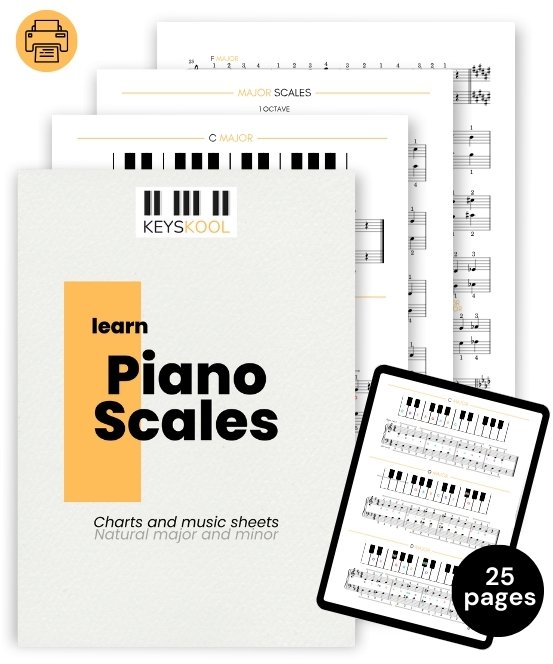Have you ever wanted to glide your fingers effortlessly across the piano keys, creating beautiful music? As a beginner, learning the correct piano finger positions is crucial to your journey. This article will guide you step by step, and to make things even easier, we’ve included 2 handy piano finger position pdf for chords and scales for you to download. Let’s embark on this exciting musical adventure together, shall we?
The infinit benefits of Learning Proper Piano Finger Position pdf
Believe it or not, your journey to becoming a proficient pianist begins with your fingers. Yes, you read that right! Mastering the correct piano finger positions is not just a minor detail, it’s an essential aspect of playing the piano effectively.
When you train your fingers to fall in the right place at the right time, you’re setting yourself up for success. Not only does it make your playing more accurate, but it also helps you play faster and more fluidly. Imagine smoothly transitioning from one chord to another, never missing a beat.
Moreover, understanding proper piano finger positioning can significantly enhance your ability to master piano chords and scales. Chords and scales are the building blocks of most music compositions. Being comfortable with them means you’ll be able to learn and play songs more easily and accurately.

Who Put My Fingers There? When Fingers Dance
What is meant by piano finger position? In simple terms, finger positioning in piano refers to where and how your fingers are placed on the keys. Proper finger positioning allows you to play notes accurately and smoothly, helping you produce beautiful music.
But here’s the thing – every finger has a role to play and a place to be. To make it easier to understand and remember, fingers are typically numbered. In both hands,
- your thumb is finger 1
- your index finger is finger 2
- your middle finger is finger 3
- your ring finger is finger 4
- and your little finger, or pinkie, is finger 5.
This numbering system is a basic and crucial part of learning piano, as it helps guide your fingers to the right keys.
To sum it up, understanding piano finger positions is all about knowing where each finger belongs on the piano and how to move them efficiently. This concept may sound simple, but it’s fundamental to your progress as a pianist. So, take your time to familiarize yourself with your piano and your fingers – your future musical self will thank you!
“The placement of the fingers on the keyboard… is part of the very soul of interpretation.” –
Frédéric Chopin
Unlocking the Mystery: A Step-by-Step Guide to Piano Finger Positions
As a beginner, it can feel overwhelming to see a piano keyboard with its 88 keys and wonder how you’re supposed to navigate them. But don’t worry. Just as every journey starts with a single step, every melody begins with a single note. And playing that note starts with knowing the correct piano finger position.
Step 1: Get Comfortable with the Keyboard
Before you start playing, take a moment to get comfortable with the keyboard. Sit in the middle of the bench, aligning your belly button with middle C. Your feet should be flat on the floor, and your elbows slightly higher than the keys.
Step 2: Understand Finger Numbering
Remember, your fingers are numbered. On both hands, your thumb is finger 1, your index finger is finger 2, the middle finger is 3, the ring finger is 4, and your pinkie is 5. This numbering system is the basis for all finger positioning in piano.

Step 3: Learn the Basic Finger Positioning
Place your right thumb (finger 1) on middle C. Then naturally lay the rest of your fingers on the consecutive white keys. So, your index finger (finger 2) should be on D, your middle finger (finger 3) on E, and so on. Do the same with your left hand on the C below middle C. Congratulations, you’ve learned the first basic finger position!
Step 4: Practice Scales to Understand Position Shifting
Scales are a great way to understand finger positioning. As you play a scale, you’ll need to shift your hand position to reach all the notes. This shift is where understanding finger positioning really comes into play.
For example, when playing a C Major scale, after you play the third note (E) with your middle finger, you’ll bring your thumb (finger 1) under your hand to hit the next note (F), effectively shifting your hand position.
Step 5: Practice, Practice, Practice
The key to mastering finger positions is practice. Regular practice will help you develop muscle memory. Over time, your fingers will naturally know where to go.
Tips and Tricks for Remembering Finger Positions
- Visualize the Keyboard: Even when you’re away from the piano, visualize the keyboard and imagine your fingers moving over it. This mental practice can be surprisingly effective!
- Slow and Steady: It’s not a race. Go slow, focus on hitting the right notes with the right fingers. Speed will come with time and practice.
- Use Your Piano Finger Position PDF: The finger position PDF we provided is a great tool. Keep it handy when practicing.
READ : The standard piano keyboard layout, which affects finger positioning, has remained largely unchanged since the 14th century – Wikipedia
Download our Piano Finger Position PDF and start your practice!
Printable How to play a piano chords with beautiful charts
How to play a piano chords ? What is a chord anyway ? Don’t worrry, we have designed a beginners friendly guide to help you learn the basic piano scales and elevate your piano learning.
Printable Practice Piano Scales PDF
Practicing piano scales is among the best exercices to get fingers strengh and agility. With our piano scales guide designed specificaly for beginners, you will master the main and basic piano scales quickly, easily and with a touch of fun.


The journey to becoming a proficient pianist begins with mastering correct piano finger positions. It enhances accuracy, speed, and fluidity in your playing. It’s crucial for mastering piano chords and scales, which are the building blocks of most musical compositions. Understanding finger positions involves knowing where each finger belongs on the piano and how to move them efficiently. As a beginner, start by getting comfortable with the keyboard, understanding finger numbering, learning basic finger positioning, practicing scales to understand position shifting, and, of course, regular practice. Patience, practice, and dedication are key in this journey. So, keep exploring the world of piano, practice with our Piano Finger Position pdf and remember, every melody begins with a single note. Happy playing!



